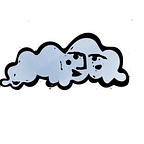The Touch, the Feel of Tablets
Comp was made for multi-touch devices from the start; compatible with, but still fundamentally different from, the desktop experience.
The app didn’t always look or function like it does now; part of our goal was to create an app that would work fluidly with familiar software like Photoshop CC, Illustrator CC and InDesign CC.
That presented a special challenge.
The process of solving this tricky riddle began in late 2013, when Khoi Vinh, Adobe’s New York-based director of product design for mobile, and Renaun Erickson, an Adobe prototyping engineer based remotely out of Battle Ground, Washington, first started collaborating. They began emailing broad ideas about app fundamentals from coast to coast. Some features — like a ‘snapshot’ tool that allowed the user to proactively save moments as she explores a design solution — were nixed after further discussion.
Others with more potential — basically anything that adhered to the overall principle of allowing users to get their ideas into visual form very quickly — transcended those initial back and forths. Erickson built those into a series of quickly realized, rough working prototypes that ran on the iPad so that the two could see for themselves how they might function in the real world. Eventually, in February 2014, they came together in NY for “one crazy week,” says Erickson, where concepts were roughed out, interactions were refined, and a version was demoed to Adobe execs.
Throughout, the pair were set on leveraging the inherent strengths and unique properties of touchscreens:
Tablets demand a much greater level of simplicity…
It’s not easy to manipulate the kind of fine-gained controls and menu options that make up the desktop software with a finger or stylus on a smaller screen.
“We wanted to let the user feel less obligated to manage the specific details — to just let them noodle — but it took us a while to find the right balance. In the beginning, we tested the ability to tap an icon to drop a pre-determined shape onto the screen. Then we wondered whether the right thing to do was give users what looked like a roughly drawn square or triangle that was closer to what they might sketch themselves. When we realized that the key was to let you get an idea out of your head and onto the screen as quickly as possible, it became obvious to let a finger (or stylus) draw whatever you wanted.” -Khoi Vinh
And allow you to work really, really fast…
Tablets allow you to mimic the familiar motions of pen-and-paper idea sessions — but can be turbocharged with instant connectivity to your computer and Creative Cloud assets.
“When we first launched, users had to tap a button to go into drawing recognition mode; we were really determined to move past that as quickly as we could, and now that mode has been removed — the app simply knows when you’re trying to draw something and translates it into a real object for you automatically. Gestures are really the driving force of the app.” -Khoi Vinh
With a streamlined process for tracking, saving, and syncing files.
Managing creative files can be a time-consuming slog through document names, storage locations, and various hierarchies; Comp’s Send to Desktop functionality, which lets users push their work in Comp to Photoshop, Illustrator or InDesign with a tap of a button, had to be straightforward, and stripped of any superfluous conventions. The same principle applied to helping users save version of their work.
“One idea we had was to allow users to take snapshots as they were working, which could be saved and sent to desktop apps; but we found that people kept forgetting to hit the camera button. We had a long discussion wondering if it was somehow possible to save virtually everything — an idea that eventually turned into our history scrubber, which allows users to roll back through their work and send any incarnation directly to Photoshop CC, InDesign CC, or Illustrator CC.” -Renaun Erickson
Now, a year after launching Comp into the world, it’s all about finding the balance between innovating from the inside — starting here with the Comp team — while regularly incorporating user feedback into the mix to keep evolving the app.
Comp is free (!) for Creative Cloud subscribers* — download it now for your iPhone or iPad. Not yet a Creative Cloud member? Sign up for a FREE Adobe ID today and try out the latest CC apps too.
*Android users, hold tight — we expect to have a beta release for you this summer.
Check out our growing visual gallery for how-tos and at-a-glance guidance on navigating Comp.
